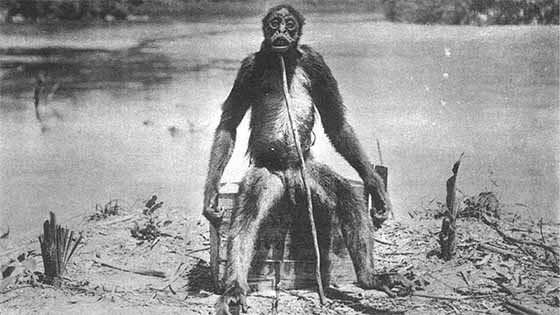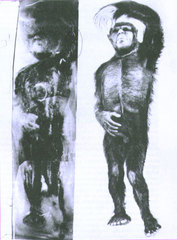Humanoid Cryptids : De Loys Ape, Orang Pendek, Yeren & Almas

In addition to the most well-known humanoid cryptid forms already mentioned - the yeti and bigfoot -, the different continents and countries offer their share of stories and testimonies relating to other types of ape-men. The recurring similarities are disturbing. How is it possible that, regardless of place and time, identical characteristics emerge? The cases exposed below only present a selection of the main cryptids. The existence of none of these humanoid creatures has never been the subject of formal proof.
The De Loys' Ape

The De Loys' Ape (Ameranthropoides loysi, but also known by the names Didi, Vasitri or Guayazi) is a species of human ape or anthropoid monkey which is localized in South America. The first accounts of its existence date back to the 16th century. As early as 1595, Sir Walter Raleigh (1552-1618) reported the first testimonies in Europe. Two centuries later, Alexander von Humboldt (1769-1859) mentions Indian stories of anthropophagous ape-men. He considers them to be bears. The accounts of the natives describe aggressive creatures, which kidnap women and kill men.
In 1920, an expedition was organized by the Swiss geologist François de Loys to find oil. In the jungle, on the edge of the Rio Tarra, between Colombia and Venezuela, the team is attacked by beings larger than monkeys, walking on two legs and devoid of tail. To defend themselves, the men of the expedition kill a female of the group. In order to photograph the animal, they sit it on a crate and hold it upright with a stick. Measuring 1.50 meters, with red fur, long arms, feet capable of grasping and thirty-two teeth (South American monkeys generally counting thirty-six), the creature has a large clitoris that can be mistaken for a penis. The French zoologist Georges Montandon, friend of De Loys, considers the specimen as a new species which he calls Ameranthropoides loysi (American anthropoid monkey of De Loys). The world of zoology welcomes this discovery with the greatest skepticism and even claims that De Loys would have cut the tail of an endemic monkey. In addition, the carnation of the animal and the size of the clitoris seem to indicate that it is a specimen of spider monkey. Opponents claim, however, that the box on which the animal was photographed measured only 45 centimeters, thus demonstrating that the size of the specimen was far too large for it to be a spider monkey. However, the height of the body and the number of teeth could not be verified. The fact that De Loys did not reveal his discovery to the public favors the thesis of authenticity. In addition, he was a geologist and was therefore not interested in the celebrity brought by the discovery of a rare animal.
The Orang Pendek
The Orang Pendek - the “little man” -, who visibly does not exceed 75 centimeters, resembles the orangutan - “the man of the woods” - and would live in the jungle of North Sumatra. These cryptids are probably a new species of primate. The Orang Pendek is distinguished from the orangutan mainly by its size, but also by its way of moving on the hind legs. Clues suggesting its existence are various footprints and remnants of fur and fabrics. These footprints are clearly distinguished from those of other humanoid cryptids such as bigfoot or yeti. But today, no evidence has been able to formally attest to its existence. One element remains however certain: the remains of fur or hair in no way correspond to those of other known monkeys or mammals. All photos of this creature have been shown to be fake or unusable. Witnesses compare him to the Paranthropus, a biped related to the ancestors of the first men. The discovery in 2004 of Homo floresiensis - a very small hominid disappeared a few millennia ago and living on the Indonesian island of Sumatra - suggests that the Orang Pendek is a descendant.
The Yeren
In the Chinese province of Hubei, this monkey-man, living in the surrounding mountains, is called Yeren, the "wild man" of Shennongjia or Yen Hsiung. Covered in red fur, it would measure between 1.50 and 2 meters. Since its first appearance in 1920, more than four hundred testimonies evoke it. Cryptozoologists believe that the Yeren is also a representative of the Gigantopithecus, presumed missing, because this region of China contains many fossils.
Almas
Legendary wild man of Mongolia, Alma would measure up to 2 meters. Covered in a reddish brown coat, it has long arms and a flat forehead. Almas are said to inhabit the mountains of Mongolia and Tien Shan, in China. The first accounts concerning them date back to the year 1420. Native people describe these creatures as “wild men”. Many expeditions have aimed to discover these mysterious creatures, the existence of which has never been truly attested, despite alleged footprints and furballs.
The Minnesota Iceman

In 1968, zoologists Sanderson and Heuvelmans went to a traveling exhibit in Minnesota. In a trailer was presented a frozen hominoid. They took a picture of it and made precise sketches of it. “It is the first time in history that the intact corpse of a Neanderthal type has been discovered. This means that this form of hominoid, then considered extinct since prehistoric times, still lives today”, wrote Heuvelmans then, brimming with enthusiasm. He assumed that the Minnesota Iceman was from Vietnam and had been brought back in bags to repatriate the remains of American soldiers. Captain Hansen, the man who exposed the creature, had indeed been sent to Vietnam in 1966. However, Hansen himself gave several versions of the circumstances of his discovery. He first claimed to have killed the creature himself in Minnesota, to have left it there and then found years later, caught in the ice. Subsequently, he said that he had found it in Siberia. He also says that he found the body in a plastic bag at the home of a Chinese man in Hong Kong. The Minnesota Iceman from the traveling exhibit eventually disappeared, as his body probably began to decompose and was replaced by an imitation. The two zoologists highlighted this deception, based on fifteen points. In 1997, another hominoid was discovered in France, similar to the Minnesota Iceman. But Heuvelmans demonstrated that this was also a hoax.









































































































































































































































































































































